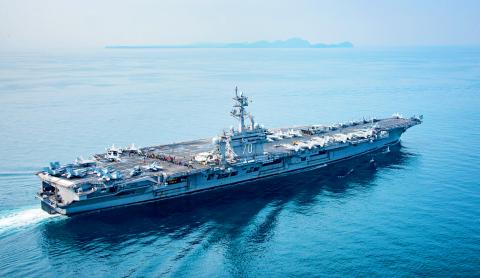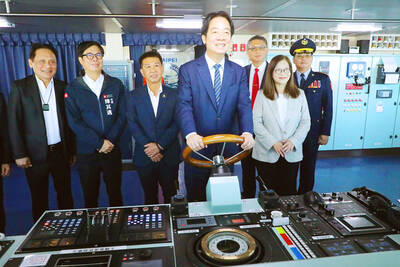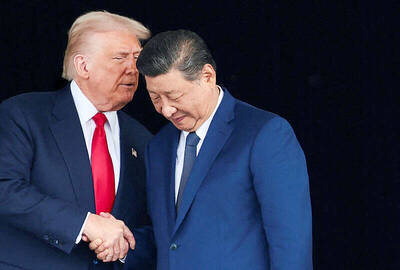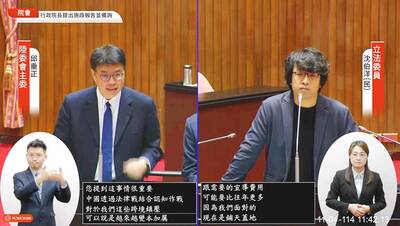A week ago, the White House said that ordering a US aircraft carrier into the Sea of Japan would send a powerful deterrent to North Korea and give US President Donald Trump more options in responding to the North’s provocative behavior.
“We’re sending an armada,” Trump told Fox News that afternoon.
The problem was that the carrier, the USS Carl Vinson, and the three other warships in its strike force were that very moment sailing in the opposite direction, to take part in joint exercises with the Australian navy in the Indian Ocean, 5,600km southwest of the Korean Peninsula.

Photo: Reuters
White House officials on Tuesday said that they had been relying on guidance from the US Department of Defense.
Defense officials described a glitch-ridden sequence of events, from an ill-timed announcement of the deployment by the military’s Pacific Command to an erroneous explanation by US Secretary of Defense James Mattis — all of which perpetuated the false narrative that a flotilla was racing toward North Korea.
By the time the White House was asked about the Carl Vinson, its imminent arrival had been emblazoned on front pages across East Asia, fanning fears that Trump was considering a pre-emptive military strike.
It was portrayed as further evidence of the president’s muscular style days after he ordered a missile strike on Syria while he and Chinese President Xi Jinping (習近平) were chatting over dessert during a meeting in Florida.
With Trump himself playing up the show of force, rolling back the story became difficult, Pentagon officials said.
The saga of the wayward carrier might never have come to light had the US Navy not posted a photograph online on Monday of the Carl Vinson sailing south through the Sunda Strait, which separates the Indonesian islands of Java and Sumatra.
It was taken on Saturday, four days after White House Press Secretary Sean Spicer described its mission in the Sea of Japan.
Now, the Carl Vinson is finally on a course for the Korean Peninsula, expected to arrive in the region next week, defense officials said.
White House officials declined to comment on the confusion, referring all questions to the Pentagon.
“Sean discussed it once when asked and it was all about process,” spokesman Michael Short said of Spicer.
However, privately other officials expressed bewilderment that the Pentagon did not correct its time line, particularly given the tensions in the region and the fact that Spicer, as well as US National Security Adviser H.R. McMaster, were publicly answering questions about it.
The miscues began on April 9 when the public affairs office of the Navy’s 3rd Fleet issued a news release saying that Admiral Harry Harris Jr, the Pacific commander, had ordered the Carl Vinson, a Nimitz-class nuclear-powered carrier, and its strike force — two destroyers and one cruiser — to leave Singapore and sail to the Western Pacific. As is customary, the US Navy did not say exactly where the carrier force was headed or its precise mission.
Given the timing, it hardly needed to: Trump had just wrapped up a two-day summit with Xi at the Mar-a-Lago resort with a message that the US had run out of patience with North Korean leader Kim Jong-un, and its nuclear and missile programs.
That Sunday, McMaster told Fox News that the deployment was a “prudent” move, designed to give the US president “a full range of options to remove” the threat posed by Kim.
What the Navy did not say was that the Carl Vinson had to carry out another mission before it could set sail north — a long-scheduled joint exercise with the Australian navy in the Indian Ocean.
The photograph that the US Navy posted of the Carl Vinson, bristling with fighter jets as it passed Indonesia, was spotted by Defense News, which broke the news that the ship was thousands of kilometers away from where the world thought it was.

CALL FOR SUPPORT: President William Lai called on lawmakers across party lines to ensure the livelihood of Taiwanese and that national security is protected President William Lai (賴清德) yesterday called for bipartisan support for Taiwan’s investment in self-defense capabilities at the christening and launch of two coast guard vessels at CSBC Corp, Taiwan’s (台灣國際造船) shipyard in Kaohsiung. The Taipei (台北) is the fourth and final ship of the Chiayi-class offshore patrol vessels, and the Siraya (西拉雅) is the Coast Guard Administration’s (CGA) first-ever ocean patrol vessel, the government said. The Taipei is the fourth and final ship of the Chiayi-class offshore patrol vessels with a displacement of about 4,000 tonnes, Lai said. This ship class was ordered as a result of former president Tsai Ing-wen’s (蔡英文) 2018

‘SECRETS’: While saying China would not attack during his presidency, Donald Trump declined to say how Washington would respond if Beijing were to take military action US President Donald Trump said that China would not take military action against Taiwan while he is president, as the Chinese leaders “know the consequences.” Trump made the statement during an interview on CBS’ 60 Minutes program that aired on Sunday, a few days after his meeting with Chinese President Xi Jinping (習近平) in South Korea. “He [Xi] has openly said, and his people have openly said at meetings, ‘we would never do anything while President Trump is president,’ because they know the consequences,” Trump said in the interview. However, he repeatedly declined to say exactly how Washington would respond in

WARFARE: All sectors of society should recognize, unite, and collectively resist and condemn Beijing’s cross-border suppression, MAC Minister Chiu Chui-cheng said The number of Taiwanese detained because of legal affairs by Chinese authorities has tripled this year, as Beijing intensified its intimidation and division of Taiwanese by combining lawfare and cognitive warfare, the Mainland Affairs Council (MAC) said yesterday. MAC Minister Chiu Chui-cheng (邱垂正) made the statement in response to questions by Democratic Progressive Party (DPP) Legislator Puma Shen (沈柏洋) about the government’s response to counter Chinese public opinion warfare, lawfare and psychological warfare. Shen said he is also being investigated by China for promoting “Taiwanese independence.” He was referring to a report published on Tuesday last week by China’s state-run Xinhua news agency,

‘ADDITIONAL CONDITION’: Taiwan will work with like-minded countries to protect its right to participate in next year’s meeting, the foreign ministry said The US will “continue to press China for security arrangements and protocols that safeguard all participants when attending APEC meetings in China,” a US Department of State spokesperson said yesterday, after Beijing suggested that members must adhere to its “one China principle” to participate. “The United States insists on the full and equal participation of all APEC member economies — including Taiwan — consistent with APEC’s guidelines, rules and established practice, as affirmed by China in its offer to host in 2026,” the unnamed spokesperson said in response to media queries about China putting a “one China” principle condition on Taiwan’s